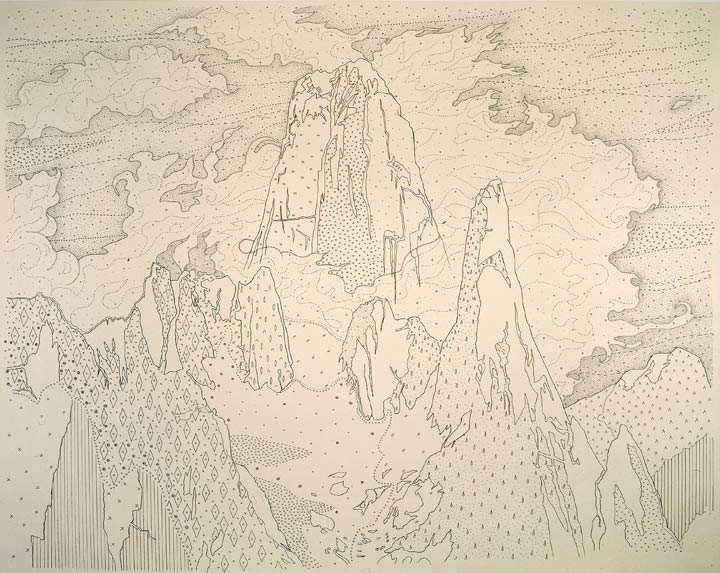"Nature is a sphere whose circumference is nowhere and whose center is everywhere"
Blaise Pascal
Over the past few months I've sat sat down and attempted to write something on the artist Robert Smithson on roughly half a dozen different occasions without much success. Smithson was never an artist that I payed much attention to in large part because his work (what little of it I knew) never held much kinship to my own artistic practice. I was aware of "Spiral Jetty" and admired it, kind of, and that's about it. So, when I came across a book of Smithsons collected writings, interviews and conversations at a thrift store for $2, I saw it as an opportunity to learn more.
Over the next 5 to 6 months, as I slowly made my way through Smithsons fascinating and at times difficult ideas on everything from pre history to crystalography (the study of crystal structures), I became increasingly impressed by the depth of Smithsons thinking and the degree to which his concerns still resonate in todays art world, a world that exists roughly half a century after his untimely death in a airplane crash.
Smithson work came out of the minimalist milieu and shared many of that groups theoretical preoccupations, but he was too willfully independent, too much of an iconoclast to ever fully invest in any one movement.
"Everyone who invents a system and swears by it, that system will eventually turn on the person and wipe him out. Its the way with everything in the sense that anything you make is basically going to turn on you, and you'll find that essentially wrong"
This declaration is as close to a mission statement as Smithson ever had, and its the reason why writing about him is so maddening. Smithson was intensely weary of certainty, a fact that is reflected in his thinking as much as in his art. Earlier in the 20th century the artist John Graham summed up the attitude of most modernist when he wrote that "art is a problem posed and solved". For Smithson, working in the late 50's and early 60's, this couldn't be further from the truth. Smithson saw his art not as a search for solutions but as dialectic in a constant state of engagement with the material world. He was not interested in problems but in relationships, none more so than the way in which the material world relates back to our mental construct of it.
To this end Smithson deployed a number of strategies often centered on elemental oppositions; inside-outside, structure-chaos, accumulation-dispersal, whole-fragment, creation-destruction, mind-matter. Out of this grew a variegated series of projects. Everything from maps, photographs, gallery installations and site specific art made all around the world. During the apotheosis of Pop, Smithson declared that he was for a "heavy, ponderous kind of art". Art that defied not only aesthetic categories but was often impossible to collect.
This last point was one of the more interesting discoveries for me. Smithson was keenly aware of the way art was being appropriated as a status symbol by the upper class and the complicity he thought museums and galleries shared in this promotion. He felt that artists should retain control over the value of their work, weather that value be expressed in economic or symbolic terms. Site specificity was a way to achieve this ideal, an attempt to throw a monkey wrench in the gears of fine art commerce. After all, how can one attempt to own a site specific piece of land art like "Spiral Jetty"? How can one display it, send it to museums for traveling exhibitions, bring it out for cocktail parties, that is to say that, without such trappings, how can one hope to increase the works value and in turn have that value increase ones status. At the end of the day one can not even hope to preserve it, "Spiral Jetty" like most of Smithson's art is meant to self destruct, to disappear in to the world that gave it birth in a slow burn of entropic erosion.
In the end, Smithson wanted to make work that existed outside any system of value, whether monetary, cultural or historic. He saw all values as ending in judgements of good or bad which in term implied moral perspectives he believed wholly incongruous with the concept of art. "Once you start seeing objects in a positive or a negative way you are on the road to derangement. Objects are phantoms of the mind, as false as angels." Smithson's art was meant to self destruct, to break apart and disintegrate back in to nothingness. This impermanence was both the essence and the real subject of the work. The aim for him was not to create something final but to engage in an open ended process whose outcome was, like all natural phenomena, in a constact permutory state of creation and collapse. The material world offered smithsom a world outside ideals of purity and systems of logic, a world that, like our minds, was always crumbling from one state of impurity in to another.



